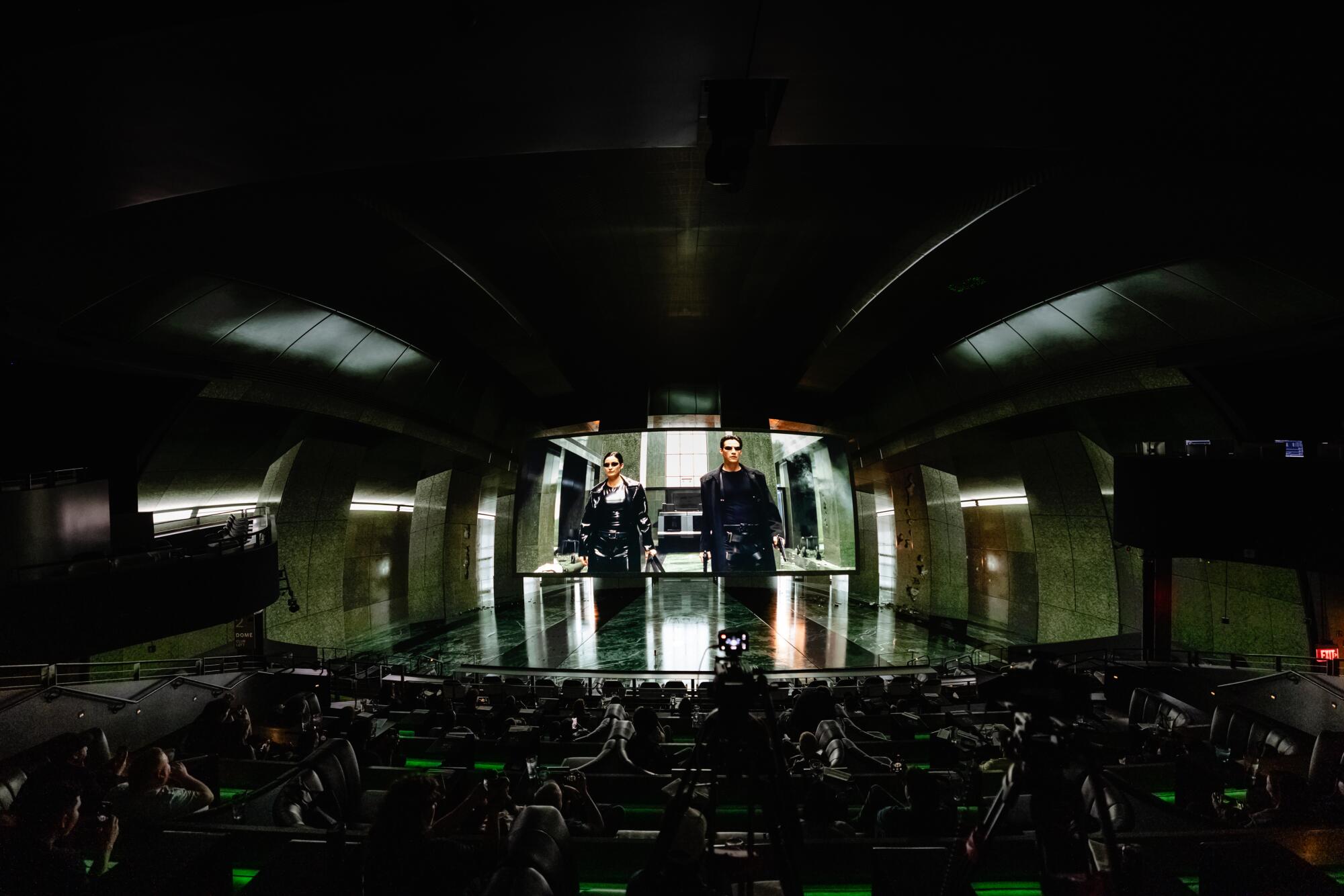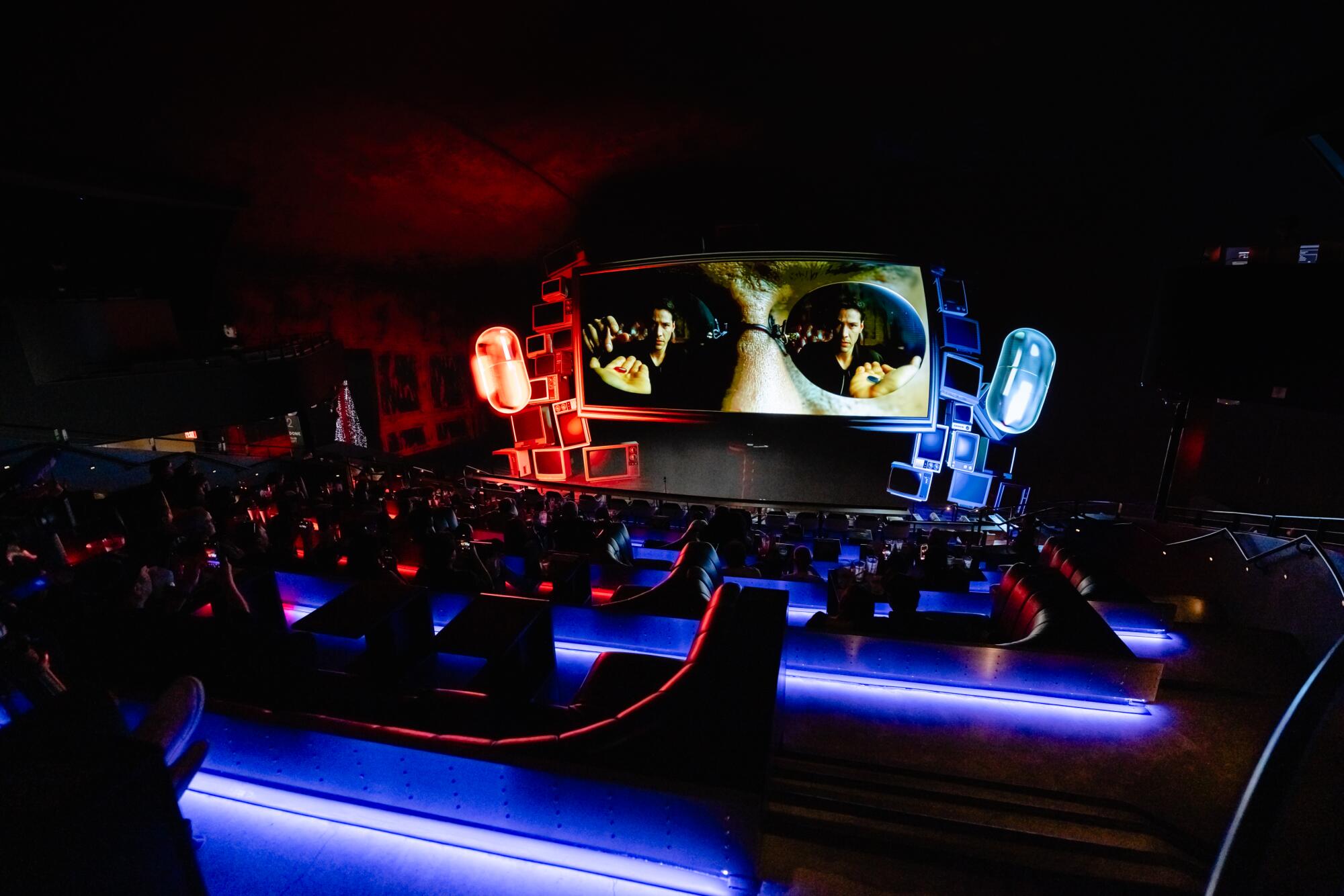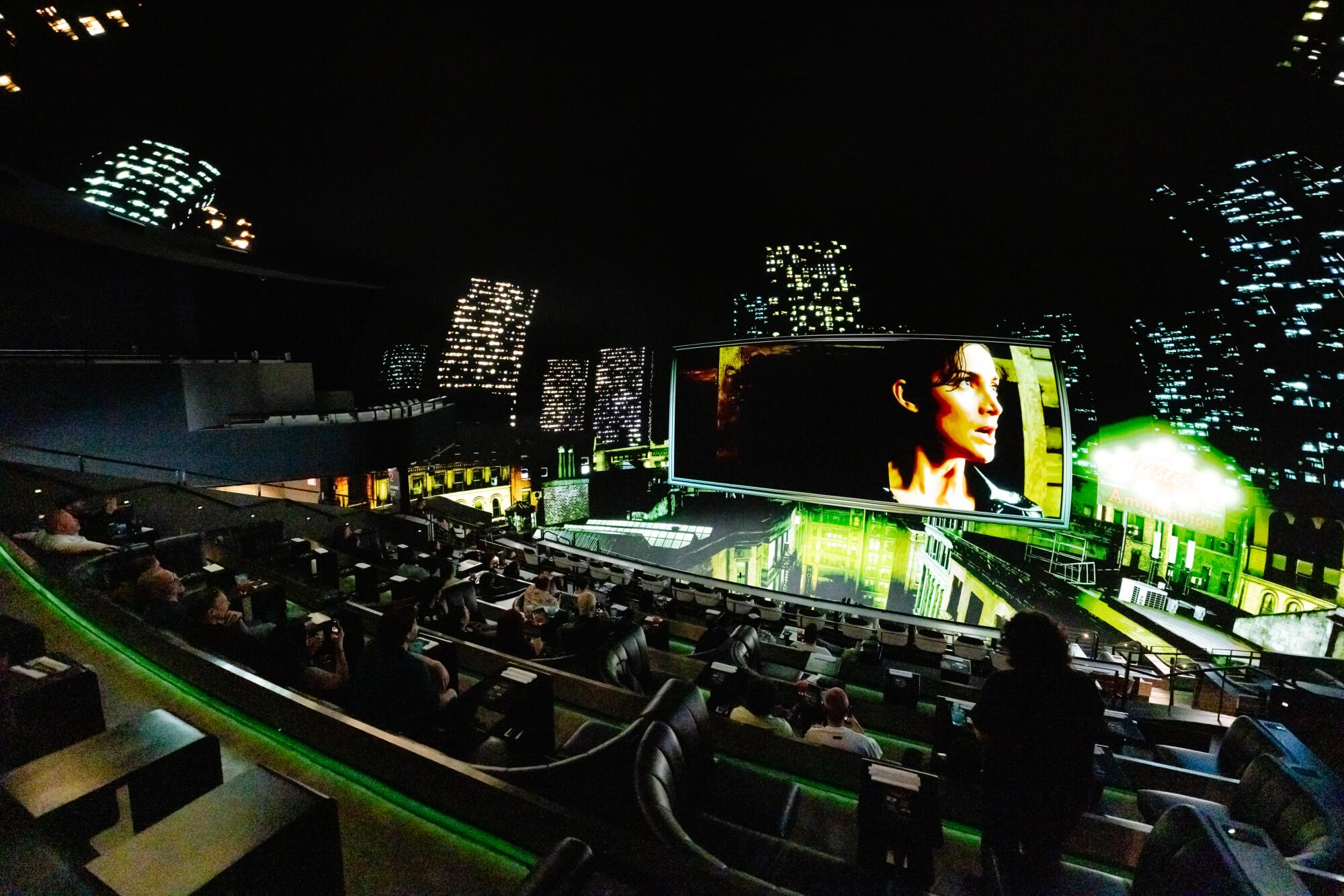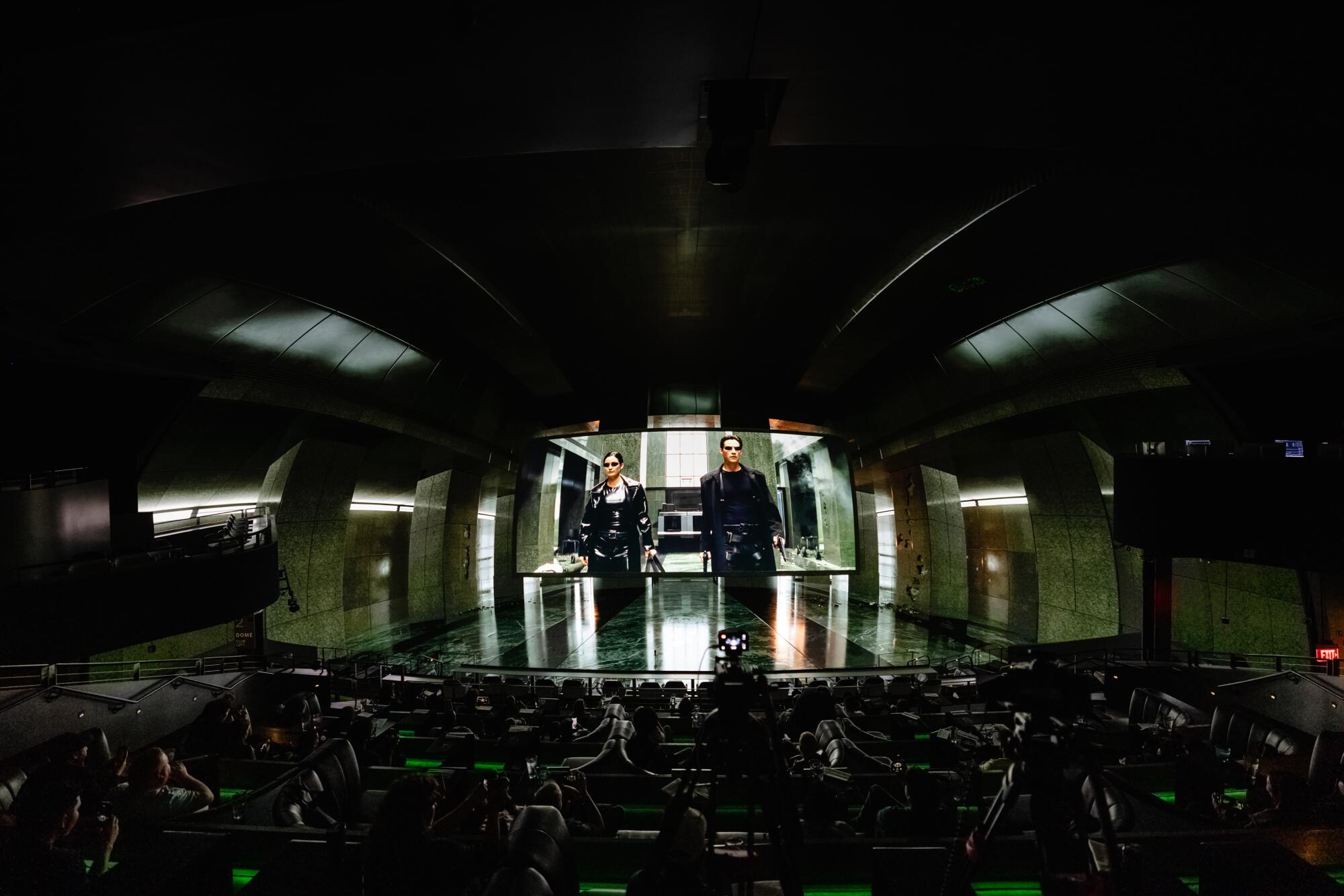When you watch “The Matrix” at Cosm, you’re essentially seeing a film within a film. A shot inside an apartment becomes a glimpse into an entire complex. A fight scene on a rooftop is now one small part of a giant cityscape. Look to the left, and a once off-screen helicopter is suddenly entirely visible.
Cosm has won attention and a fan base for its focus on sports programming. A domed, 87-foot-diameter wraparound screen surrounds audiences at the Inglewood venue, creating an illusion of in-the-flesh presence. Can’t make it to that NBA Finals or World Series game? Cosm wants to be your fallback plan, combining front-row-like seats with unexpected views.
And now, Cosm aims to redefine the moviegoing experience. A revival of “The Matrix” opens Thursday in what the company calls “shared reality,” a marketing term that ultimately means newly created CGI animation towers, over, under and around the original 1999 film. Cosm has in the past shown largely short-form original programming, and “The Matrix” marks its first foray into feature-length films.

Carrie-Anne Moss and Keanu Reeves in “The Matrix,” which is opening at Cosm with newly created CGI that surrounds the original frame.
(Cosm )
The hope is to not only see the film with fresh eyes but to create a sensation of being in the same environment as Keanu Reeves’ Neo, Carrie-Anne Moss’ Trinity and Laurence Fishburne’s Morpheus. “The Matrix” is an ideal film for this experiment, its anti-AI message decidedly topical while its themes grapple with dual visions of reality.
There’s been a host of so-called immersive ambitions to alter the moviegoing experience over the decades, be it the on-and-off flirtation with interactive cinema, a brief trend in the ’90s that recently lived again on Netflix (see “Black Mirror: Bandersnatch”), to more recent 4-DX theaters with movement-enabled seats (see the light, water and wind effects of “Twisters”). Cosm, like the bigger, more live music-focused Sphere in Las Vegas, seems to have a different pitch: an all-encompassing screen that can provide previously unexplored vantage points, even at times creating a theme park ride-like sense of movement.
Cosm’s interpretation of “The Matrix,” a collaboration with experiential creative agency Little Cinema, envelopes audiences from its opening action sequence when a nighttime view of a city skyline seemingly places us on a rooftop. Elsewhere, Neo’s office building becomes a maze of cubicles. The film’s centerpiece red pill versus blue pill moment centers the frame among oversized, glowing capsules. When Neo awakens, we are lost amid mountainous, industrial pods.
The challenge: To not make it feel like a gimmick, yet to also know when to pull back and let the film stand for itself. “The No. 1 core principle was to enhance and don’t overshadow,” says Jay Rinsky, founder of Little Cinema. “Metaphorically for us, the movie itself is the lead singer and we are the backing band. Let the movie be the star. Let it sing. And basically follow the key beats — follow the sound design, the emotional moments and enhance the action.”

The red versus blue pill scene in “The Matrix” is framed with newly created animation.
(Cosm)
The accompanying images get more aggressive as the film races toward its climax. The animations are most effective when they’re expanding the screen rather than echoing the action — showing us the viewpoint of a careening helicopter for instance, rather than repeating or mimicking a beat of the film. Having seen “The Matrix” before, I know the story and its cadence, and was perhaps more willing to turn my attention away from the film, which is placed in the center of the screen and often set within a picture frame.
In turn, I was dazzled by the scenes shot inside Morpheus’ hovercraft the Nebuchadnezzar, in which the vessel’s surroundings — its buzzing, electrical core and its assortment of monitors — are fleshed out around the screen. Film purists, I wonder, may balk at seeing images beyond the director’s vision — Rinsky says he hasn’t been in touch with directors Lana or Lilly Wachowski — but I found it could help build a world, especially for revival cinema on a second or third viewing.

A scene of “The Matrix” starring Carrie-Anne Moss is surrounded with an all-surrounding view of a skyline.
(Cosm)
Expectedly, the film’s final act becomes a bevy of secondary action. Bullets that fly off the frame of the film now find a landing spot, as building walls shatter and crumble around us. Cosm’s screen is crisp and encompassing enough that it can mimic movement or flight, and thankfully this is used sparingly, twisting only when the film’s characters take to the skies.
When Cosm opened last summer Chief Executive Jeb Terry stressed the venue wasn’t in the business of showing films, wanting to focus on sports or original programming. “We’re not a first-run theater,” said Terry. “We’re leaning into the experiential side.” Seemingly, “The Matrix” fits this plan, as the accompanying CGI images have been in the works since about August 2024, says Rinsky, with the bulk of the heavy lifting beginning in January.
Rinsky acknowledges “The Matrix” fits the format particularly well because it “plays in a realm of fantasy that allows you to change environments around,” but is quick to add that Cosm and Little Cinema hope to expand the program of enhancing Hollywood products. “It is a bit of a mission and a philosophy,” he says. “Every film in every genre has its own unique propositions and can be adopted and suited well. We’re excited about horror, and we’re excited about comedy.” Future projects have not yet been announced.
Cosm also has a venue in Dallas, with spots in Atlanta and Detroit on the way. Rinsky’s hope, of course, is that Cosm someday has enough market penetration that filmmakers can create the format from the ground up.
“I’m really bullish about this being the new cinema,” Rinsky says. “I think in five to 10 years, there will be 100 of these around. Once it hits scale, then big studios will have releases created specifically for this format.”
It’s an optimistic view of the future that’s arriving at a time of disruption in Hollywood, from shake-ups due to the streaming market to artificial intelligence. For Cosm, it’s the early days, but it’s a vision that needs neither a red nor blue pill. Its outlook is much more rose-colored.
